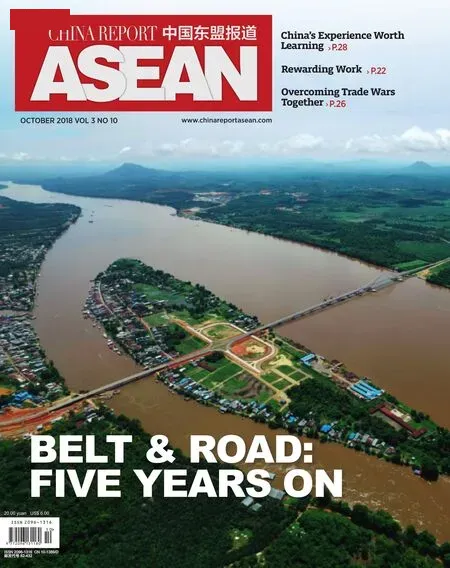BELT & ROAD: FACTS & FIGURES
By Yang Daoling
Analysis of about 50 million pieces of data collected from mainstream news media and social media both at home and abroad between September 1, 2013 and May 30, 2018 shows that since it was proposed five years ago, the Belt and Road Initiative (BRI) has made remarkable progress in promoting policy coordination, connecting infrastructure and facilities, streamlining trade, integrating financing and fostering closer people-to-people ties along the route. The Initiative has achieved increased global signi ficance over the past five years, while at the same time it faces new challenges.
First, the BRI is gaining increasing attention from the international community. Chinese and foreign media have kept a close eye on the Initiative since it was first announced in 2013 (see Chart 1). Milestone events and announcement of top-level planning have drawn global attention, including the white paperJoining Hands to Build a Silk Road Economic Belt and a 21st-Century Maritime Silk Road – Vision and Actionsissued in March 2015, founding of the Asian Infrastructure Investment Bank (AIIB) in December 2015, the Belt and Road Forum for International Cooperation held in May 2017, and the inclusion of the Initiative into the Party Constitution in October 2017. Countries in Europe, North America, Northeast Asia and Southeast Asia have paid closest attention to the grand plan, especially the United States, the United Kingdom, Russia, India and South Korea (see Chart 2).
Chart 1: World Attention on the BRI from September 2013 to March 2018

Chart 2: Countries Paying Closest Attention to the BRI from September 2013 to March 2018

Chart 3: Proportion of Foreign Media and Netizens Supporting the BRI

The BRI has earned wide support from the international community. Global opinion on the Initiative has transitioned from a wait-and-see attitude to questioning, support and cooperation. More and more people around the world maintain a positive attitude toward the Initiative, with the percentage increasing from 16.5 percent in 2013 to 23.67 percent in 2017 (see Chart 3).
Third, notable achievements have been made in promoting infrastructure connectivity along the Belt and Road. China has carried out many railway and port construction projects in cooperation with countries along the route. Since the China-Europe Railway Express was launched in 2011, the number of trains put into service has exploded over the years (see Chart 4). Infrastructure projects connecting China and other Eurasian countries have been advancing rapidly such as the New Eurasian Land Bridge, China-Indochina Peninsula Economic Corridor, China-Mongolia-Russia Economic Corridor and China-Pakistan Economic Corridor. Signi ficant progress has been achieved in the construction of China-Thailand Railway, China-Laos Railway, Budapest–Belgrade Railway and container freight stations at Khalifa Port of the United Arab Emirates.
Chart 4: Development of China-Europe Railway Express

Fourth, with bilateral trade and investment constantly growing, China has built closer economic ties with its partners along the Belt and Road. Trade volume between China and countries along the route grew faster than that between China and countries in other regions (see Chart 5 and Chart 6). The year 2017 saw trade volume of US$144.03 billion between China and its partners along the route, up 13.4 percent over the previous year and 5.9 percent higher than the overall growth rate of China’s foreign trade. It also accounted for 36.2 percent of China’s total foreign trade. China’s non- financial direct investment in 59 countries along the Belt and Road continued increasing from 2013 to 2016 (see Chart 7),and it made a total of US$14.36 billion in investments in these countries in 2017.
Chart 5: China’s Trade with Countries along the Belt and Road and Total Foreign Trade

Chart 6: Growth Rate of Trade Between China and Countries along the Belt and Road and China’s Total Foreign Trade

Chart 7: China’s Non- financial Direct Investment in Countries along the Belt and Road

Against changing international and regional landscapes with growing destabilizing factors, Chinese and foreign media have identi fied a number of new challenges for further implementation of the BRI (see Chart 8).
Chart 8: Challenges for the BRI Identi fied by Chinese and Foreign Media

In terms of human resources development, multi-skilled talent with global vision is needed for construction and operation of China’s overseas projects,especially professionals with expertise in language, financial management, law and education (see Chart 9).
Chart 9: Professionals Most Needed along the Belt and Road


